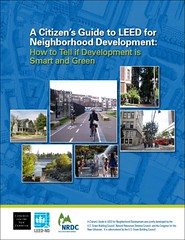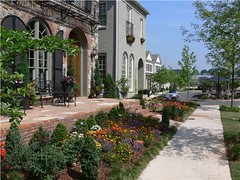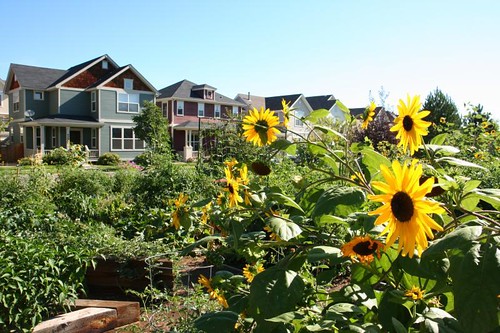Knowing when it's green: A Citizen's Guide to (LEED for) Neighborhood Development

Posted May 25, 2011 at 4:31PM
If you are like most of us, you have wondered whether or not a proposal for new development in your community was a good idea, whether it was environmentally friendly, or whether you should support it. A Citizen’s Guide to LEED for Neighborhood Development is a hands-on introduction that NRDC developed for local environmental groups, smart growth organizations, neighborhood residents and just about anyone interested in making our communities better and greener. It is available for free and can be downloaded here.
LEED-ND is a comprehensive and logical rating system that reflects the most current thinking about smart, green, sustainable, and well-designed neighborhoods. For neighborhood-scale development to be certified by the US Green Building Council as environmentally exemplary,  it must meet the criteria contained in the LEED for Neighborhood Development rating system.
it must meet the criteria contained in the LEED for Neighborhood Development rating system.
Those projects that score higher under the criteria are awarded higher ratings. Developments and neighborhoods that earn high scores under LEED-ND will generally have lower levels of emissions of carbon and conventional air pollutants; generate less stormwater runoff; use land more efficiently and wisely; conserve natural and material resources better; be more walkable; and promote public health to a greater degree than conventional development. LEED-ND was jointly developed by NRDC, the USGBC, and the Congress for the New Urbanism; it is administered by USGBC.
But the principles embodied in LEED-ND can be applied to situations other than those in which a development is seeking certification. While the formal LEED-ND process is a technical one, the Citizen’s Guide is user-friendly and accessible, to help anyone learn about environmental standards for green land development and become an advocate for implementing these standards in their own communities.  NRDC hopes this handbook for citizens will help promote greater widespread adoption of sustainable practices to create more inclusive, healthy, and environmentally sound places for everyone.
NRDC hopes this handbook for citizens will help promote greater widespread adoption of sustainable practices to create more inclusive, healthy, and environmentally sound places for everyone.
Following two short introductory sections (“How to Use This Guide” and “What is a Sustainable Neighborhood?”), the Guide identifies key concepts for neighborhood sustainability, referencing the LEED-ND credits and prerequisites that inform each. These follow the three major sections of the formal rating system:
- Smart Location and Linkage: Where to Build
- Neighborhood Pattern and Design: What to Build
- Green Infrastructure and Buildings: How to Manage Environmental Impacts
The next section, “How Can LEED-ND Help Improve Your Community?” provides some creative suggestions to help  users get started using LEED-ND’s diverse standards in their own communities. The system’s principles can be used, for example, to evaluate and improve development proposals, to guide improvements to neighborhoods, to inform community planning and zoning, or to inform other policy-making.
users get started using LEED-ND’s diverse standards in their own communities. The system’s principles can be used, for example, to evaluate and improve development proposals, to guide improvements to neighborhoods, to inform community planning and zoning, or to inform other policy-making.
The Guide also includes a “Sustainable Neighborhood Development Checklist.” The checklist is a sort of “crib sheet” for every LEED-ND credit and prerequisite, presenting them in an easy-to-use format for evaluating development proposals, assessing existing neighborhoods, and informing community planning and policy. The checklist is organized by topic, so one can use it in its entirety or just to evaluate certain topics. It also includes an optional scoring exercise so users can estimate what an approximate LEED-ND score might be for a particular project or proposal. It is also a great source for nationally-tested standards or numerical thresholds to incorporate into design guidelines or planning policy.
 The Citizen’s Guide concludes with a reference appendix outlining the LEED-ND Rating System, and another appendix summarizing the basics of formal LEED and LEED-ND certification procedures.
The Citizen’s Guide concludes with a reference appendix outlining the LEED-ND Rating System, and another appendix summarizing the basics of formal LEED and LEED-ND certification procedures.
NRDC wishes to thank the following: Aaron Welch, the Guide’s principal author, and his colleagues at Raimi + Associates; the US Green Building Council and the Congress for the New Urbanism, our partners in LEED-ND’s development, for creating the system with us and providing helpful advice and assistance in producing the Guide; Dover, Kohl & Partners, especially for help with images; and our advisory council, whose names are listed in the Guide. I also wish to thank my NRDC colleagues Carlita Salazar, who supervised design and production; Anthony Clark, NRDC’s publications director; Will Tam, who supervised web production; Rachel Sohmer, who provided content and help with images; and Marissa Ramirez, who provided editorial and production assistance throughout the process.
For more information about the Guide, about LEED-ND, and a slideshow of sustainable practices, go here. To proceed directly to download of A Citizen’s Guide to LEED for Neighborhood Development, go here.
Move your cursor over the images for credit information.
